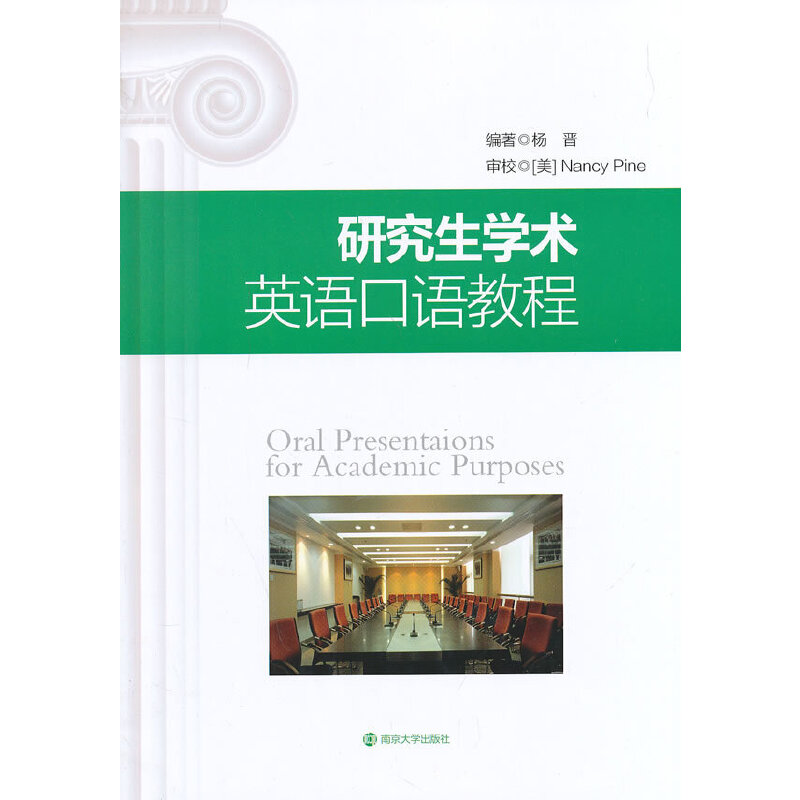- 南京大学
- 9787305102691
- 137462
- 2014年4月
- H319.9
Preface
Unit 1 Preparation and Planning
1.1 Why should we make oral presentations?
1.2 A piece of advice from an experienced scholar
1.3 Essential elements you should consider before preparing a presentation
1.4 More considerations on the room and the audience
1.5 Write a manuscript for the oral presentation
1.5.1 A sample outline
1.5.2 Students' samples
1.6 Budget enough planning time
Unit 2 Structure of Oral Presentation(Part 1)
2.1 Handouts
2.2 The beginning of the presentation.Attract the attention of audience
2.3 The beginning of the presentation: Identify yourself
2.3.1 The expressions
2.3.2 Start the presentation
2.3.3 Greet the audience
2.4 Introducing yourself (name, position, company)
2.5 When you are asked to chair the meeting or a conference
2.6 Give the title and introduce the subject
2.7 Have you estimated the time you will take?
2.7.1 The importance of timing your presentation
2.7.2 How to time your presentation?
Unit 3 Structure of Oral Presentation(Part 2)
3.1 Give the purpose (aim, goal, etc.) of the presentation
3.2 Give the outline of the speech
3.3 Announce the rules o|" questions and answers to the audience
3.4 It is time to move to the body of your presentation
3.5 Move to the next point
Unit 4 The Main Part of the Body
4.1 Make a clear-focused speech
4.1.1 Research your topic by using websites
4.1.2 Use only relevant materials
4.1.3 Stay focused on your topic
4.2 Sequence your ideas smoothly
4.3 How to keep the audience's attention?
4.4 How to signpost your audience
4.5 Simplify your language and sentence-structure to accommodate a listening audience
Unit 5 To Conclude Your Speech
5.1 The major parts in the conclusion
5.2 Structure: Signpost the end of your talk
5.3 To conclude
5.4 Invite questions
5.5 Deal with difficult questions
5.6 Answer questions
5.7 Ask questions
Unit 6 The Delivery of Your Speech
6.1 Rehearse your speech
6.1.1 Record your speech
6.2.2 Dos and don'ts in rehearsal
6.2 Deliver your speech
6.2.1 Deliver your speech to three kinds of audience
6.2.2 Develop a sense of rapport with your audience
6.2.3 Forget "delivering a presentation"
6.3 Reading manuscript
6.4 Body language and movement
Unit 7 Visual Aids
7.1 The importance of using visual aids
7.2 The function of visual aids
7.3 When to use visual aids?
7.4 Types of visuals
7.5 The use of PowerPoint
7.6 How to arrange visual aids
7.7 Delivery
7.8 How do you present visuals in a presentation?
7.9 Summary
Unit 8 Using Citations and Avoiding Plagiarism in Oral Presentation
8.1 Academic honesty
8.2 Plagiarism
8.3 How to avoid plagiarism
8.3.1 Types of plagiarism
8.3.2 How to cite sources?
8.3.3 What is a citation?
8.4 How do you cite material?
8.4.1 Mention the source the first time you cite it
8.4.2 The difference between oral citation and written citation
8.5 How to cite quotations during an oral presentation
8.6 Guard against plagiarism
Unit 9 Coping with Speech Anxiety
9.1 Speech anxiety and career development
9.2 Analyze speaking anxiety
9.3 Realize the difference between spoken English and written English
9.4 Methods of Coping with speech anxiety
9.5 Try to win your audience back
9.6 Other things you can do to ease speech anxiety
9.7 Emphasize the use of visual aids
9.8 Take care of your body movements
9.9 Learning from great speakers
Unit 10 Oral Presentation Assessment Criteria
10.1 The choice of assessment criteria
10.2 Some common features of assessment criteria in oral presentations
10.3 Assessment criteria of oral presentations for different purposes
10.4 Peer assessment
Appendix
References



